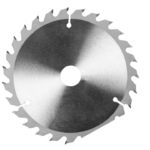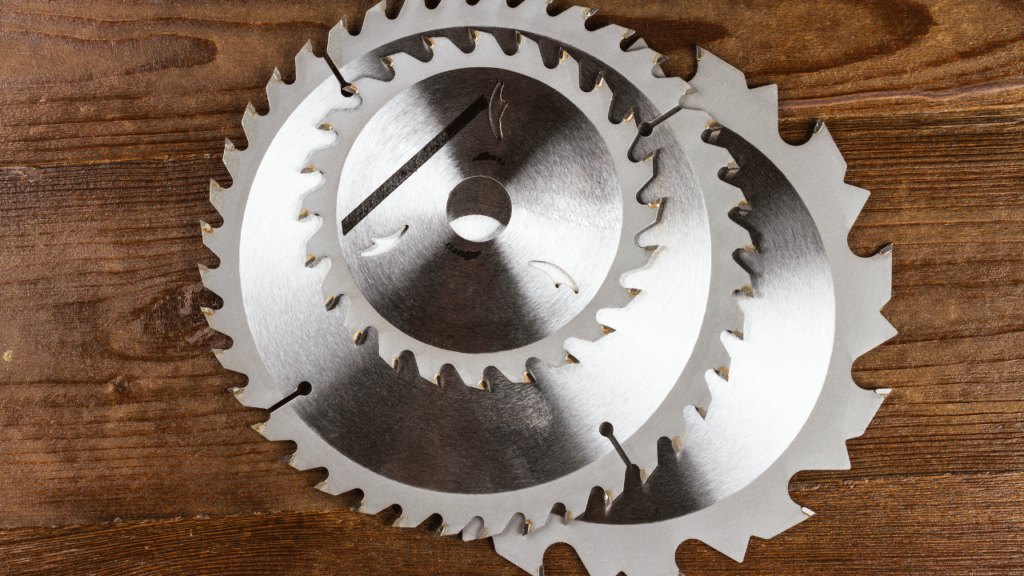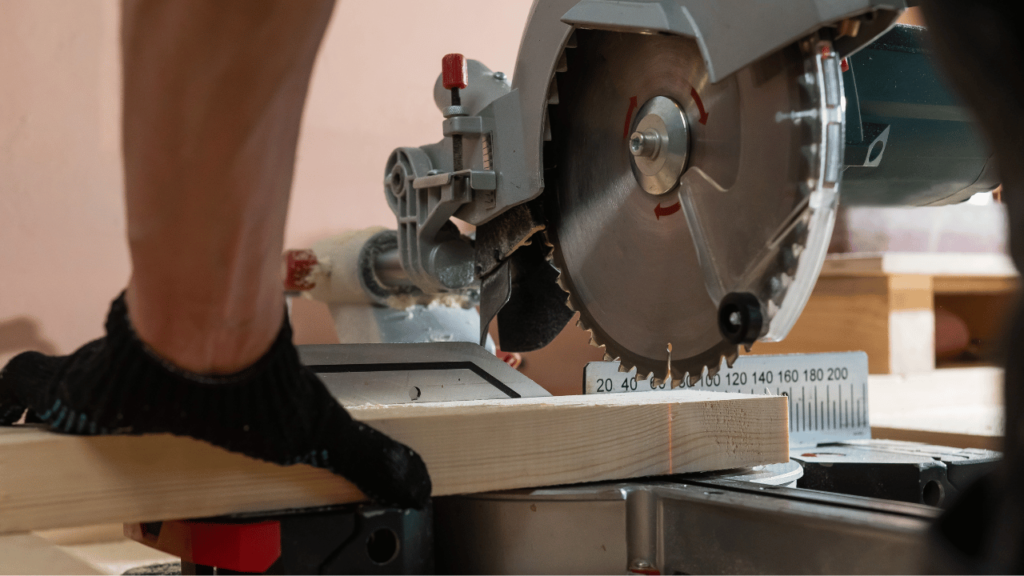Have you ever tried cutting wood, metal, or plastic and noticed the results could have been smoother than you’d like? After years in construction using various saws, I’ve found that the key often lies in the type of circular saw blade you choose.
Throughout my experience with various projects, I’ve learned that using the right circular saw blade is crucial. Blades come in different shapes and sizes, each suited for specific tasks—some make cutting wood easy, while others are tough enough for materials like metal or concrete.
In this article, I’ll discuss 11 types of circular saw blades, explain how they work, and help you choose the best one for your project. Let’s get started!
11 Types of Circular Saw Blades and their uses
Circular saw blades are designed for specific materials and cutting tasks, making it essential to choose the right one for your project. Here’s a breakdown of the most common types of circular saw blades and their uses:
1. Rip-cut blades

Purpose: Designed to cut along the grain of wood.
Characteristics:
- Fewer teeth (14–24 for a 10″ blade).
- Deep gullets to remove material quickly.
- Aggressive cutting angle.
Uses: Ideal for fast, rough cuts in hardwood and softwood.
2. Crosscut Blades

Purpose: For cutting across the grain of wood.
Characteristics:
- Higher tooth count (60–80 for a 10″ blade).
- Teeth are beveled to create cleaner cuts.
- Slower cutting speed but smoother results.
Uses: Perfect for precise cuts on furniture-grade materials.
3. Combination Blades

Purpose: Versatile blades that perform both rip and crosscuts.
Characteristics:
- Moderate tooth count (typically 40–50).
- Grouped teeth arrangement (e.g., five teeth followed by a large gullet).
Uses: Great for general-purpose cutting when frequent blade changes aren’t practical.
4. Specialty Wood Blades
Plywood Blades:
- Fine teeth to prevent splintering thin layers of wood.
- The best type for plywood to achieve clean cuts.
Finish Blades:
- High tooth count (80+), designed for ultra-smooth cuts in hardwood and softwood.
Framing Blades:
- Durable blades for construction lumber and rough carpentry.
5. Metal-Cutting Blades
Purpose: Cut ferrous (steel) and non-ferrous (aluminum) metals.
Characteristics:
- Fewer teeth with carbide or diamond-tipped edges.
- Heat-resistant coating to withstand high temperatures.
Uses:
- Aluminum and thin sheets: Use blades with 60–80 teeth.
- Thick steel: Opt for diamond-tipped blades.
6. Masonry Blades
Purpose: Designed to cut stone, brick, concrete, and asphalt.
Characteristics:
- Diamond-grit edges for durability.
- Segment design for cooling and debris removal.
Uses:
- Concrete and asphalt: Segmented diamond blades.
- Tile and stone: Continuous rim diamond blades for smooth edges.
7. Plastic-Cutting Blades
Purpose: For materials like plexiglass, acrylic, and PVC.
Characteristics:
- Fine-tooth blades or blades with negative hook angles to reduce chipping.
Uses: Prevents cracking and ensures smooth cuts.
8. Laminate and Composite Blades
Purpose: Cuts laminate flooring, countertops, and composite decking.
Characteristics:
- Carbide-tipped teeth for durability.
- High tooth count for clean, chip-free cuts.
Uses:
- Laminate countertops and flooring.
- Composite decking and MDF.
9. Demolition Blades
Purpose: Heavy-duty cutting in demolition work.
Characteristics:
- Reinforced teeth to handle nails, screws, and other debris.
- Hardened body to resist warping.
Uses: Cutting through wood with embedded materials.
10. Fine-Finish Blades
Purpose: For precision woodworking and cabinetry.
Characteristics:
- Ultra-high tooth count (80–100).
- Alternate Top Bevel (ATB) or Hi-ATB tooth configuration for sharp, splinter-free edges.
Uses: Trimming and detail work.
11. High-Performance Blades
Purpose: Long-lasting, sharper blades for demanding applications.
Characteristics:
- Advanced materials like titanium or carbide.
- Coatings to resist heat and corrosion.
Uss: Prolonged cutting with minimal wear.
Choosing the Right Blade for Your Project

Choosing the correct circular saw blade can make a big difference in the smoothness, cleanliness, and ease of your cuts. Let’s break it down to help you decide which blade you need for different materials and projects.
Step 1: What Material Are You Cutting?
Different materials need different blades. Here’s a quick guide:
- Wood: Use blades designed for wood, such as rip or crosscut blades.
- Metal: Look for a blade with carbide or diamond tips for cutting metal.
- Laminate or Melamine: Use a fine-tooth blade to prevent chipping.
- Plastic or Plexiglass: Choose a blade with small, fine teeth to avoid cracking.
- Concrete or Asphalt: Use a diamond-tipped masonry blade for these challenging materials.
Step 2: What Kind of Cut Do You Need?
The way you cut the material also matters:
- Rip Cuts (cutting along the grain): A rip blade with fewer teeth (14–24) will cut faster but might leave rough edges.
- Crosscuts (cutting across the grain): A blade with more teeth (60–80) will give smoother edges.
- Combination Cuts: Use a combination blade to make rip and crosscuts without switching blades.
Step 3: How Smooth Should the Finish Be?
The finish depends on the tooth count:
- Rough Finish: Fewer teeth cut faster but leave rough edges. Great for Framing Framing or rough carpentry.
- Smooth Finish: More teeth mean a slower cut but a softer edge. Perfect for furniture or detailed projects.
Example Scenarios
Here are a few joint projects and the type of blade you should use:
Cutting 2x4s for Framing
- Blade Type: Use a general-purpose or Framing blade with 24 teeth.
- Why?: This blade is tough enough for construction lumber and cuts quickly without worrying about smooth edges.
Building a Door (What Type of Blade to Cut Doors?)
- Blade Type: A fine-tooth blade with 60–80 teeth.
- Why?: This ensures a smooth, clean edge on the wood or laminate used for doors.
Cutting Butcher Block
- Blade Type: A high-tooth-count blade (80+), preferably carbide-tipped.
- Why?: Butcher block is dense, and a fine blade prevents splinters and tear-out, leaving smooth edges.
Working with Melamine
- Blade Type: A blade with a Triple Chip Grind (TCG) and 80–100 teeth.
- Why?: Melamine can chip easily, and this blade will give you a clean, chip-free cut.
Cutting Laminate Countertops or Flooring
- Blade Type: A fine-tooth carbide blade with 80–100 teeth.
- Why?: Laminate is prone to chipping, and this blade ensures clean edges.
Safety Precautions When Using Circular Saw Blades

Using circular saw blades can be dangerous if you don’t follow safety rules. Here are some simple safety tips to keep you safe while working.
Wear the Right Safety Gear
- Always wear safety glasses to protect your eyes from flying debris.
- Use hearing protection to reduce damage from the saw’s loud noise.
- Wear gloves if handling sharp blades, but avoid them during cutting to maintain control.
- Keep long hair tied back and avoid loose clothing.
Check the Blade Before Use
- Inspect the blade for cracks or damage before installing it.
- Make sure you use the right blade for your saw and project.
- Install the blade correctly, with the teeth facing the proper direction.
- Tighten the blade securely to prevent it from wobbling.
Prepare Your Work Area
- Keep your workspace clean and free of clutter.
- Use clamps to hold the workpiece securely. This keeps it from moving while cutting.
- Never hold the material with your hand near the blade.
Use Your Saw Safely
- Follow the manufacturer’s instructions for your saw and blade.
- Make sure the saw is turned off and unplugged when changing blades.
- Please wait for the blade to stop spinning before removing it from the material.
- Keep both hands on the saw when cutting for better control.
Be Aware While Cutting
- Stand to the side of the saw, not directly behind it. This protects you from kickback.
- Watch the blade closely and cut slowly for accuracy and safety.
- Never force the saw. Let the blade do the work.
Maintain Your Tools
- Clean your blades regularly to remove sap, resin, or debris.
- Sharpen dull blades or replace them as needed.
- Keep your saw in good working condition to prevent accidents.
FAQs
What kind of circular saw blade cuts metal?
A metal-cutting blade with carbide-tipped or diamond-coated teeth works best. Use a blade with fewer teeth for cutting thick metal, and choose a high-tooth-count blade for aluminum or thin sheets. These blades are heat-resistant and durable.
What type of circular saw blade is used to cut plywood?
A fine-tooth plywood blade with 60–80 teeth is ideal. This type of blade prevents splintering and leaves clean, smooth edges. It’s perfect for delicate cuts where precision matters.
What type of circular saw blade is used to cut melamine?
Cut melamine with a Triple Chip Grind (TCG) blade with 80–100 teeth. This blade cuts cleanly through melamine without causing chipping or rough edges. It’s designed for materials with delicate surfaces.
What type of circular saw blade is used to cut the laminate countertop?
A fine-tooth carbide blade with 80–100 teeth is best for cutting laminate countertops. This blade ensures smooth cuts and prevents chipping or cracking on the laminate surface.
What type of circular saw blade is used to cut laminate flooring?
A carbide-tipped fine-tooth blade is excellent for laminate flooring. Look for blades with 80–100 teeth to make clean, chip-free cuts that keep the material intact and smooth.
What type of circular saw blade to cut plexiglass?
Use a fine-tooth blade with small, sharp teeth to cut plexiglass. Blades designed for plastic or acrylic work best, cutting without cracking or melting the material.
What type of circular saw blade is used to cut concrete?
A diamond-tipped masonry blade is the best choice for cutting concrete. It’s tough enough to handle the hard material and cuts cleanly without quickly wearing down.
What type of circular saw blade is used for composite decking?
A carbide-tipped blade with 40–60 teeth works well for composite decking. This blade is durable and provides smooth cuts without damaging the composite material.
What type of circular saw blade to cut doors?
A fine-tooth carbide blade with 60–80 teeth is the best option for cutting doors. It ensures a smooth edge, whether the door is wood, laminate, or composite.
What type of circular saw blade is for MDF?
To cut MDF, use a Triple Chip Grind (TCG) blade with 80–100 teeth. This blade is designed for dense materials like MDF and makes precise, clean cuts without causing splinters or rough edges.
Choosing the right circular saw blade is essential for getting the best results on any project. The correct blade makes your cuts cleaner, faster, and safer. It also helps you avoid wasting time and materials. Whether cutting wood, metal, or other materials, always match the blade to the material and type of cut.
If you still need to figure it out, start with a general-purpose blade and experiment as you learn more. Check your saw’s manual for the correct blade size and type.
Have you tried different types of circular saw blades? Share your experiences in the comments below! We’d love to hear what worked for you and your projects. Let’s learn together!

